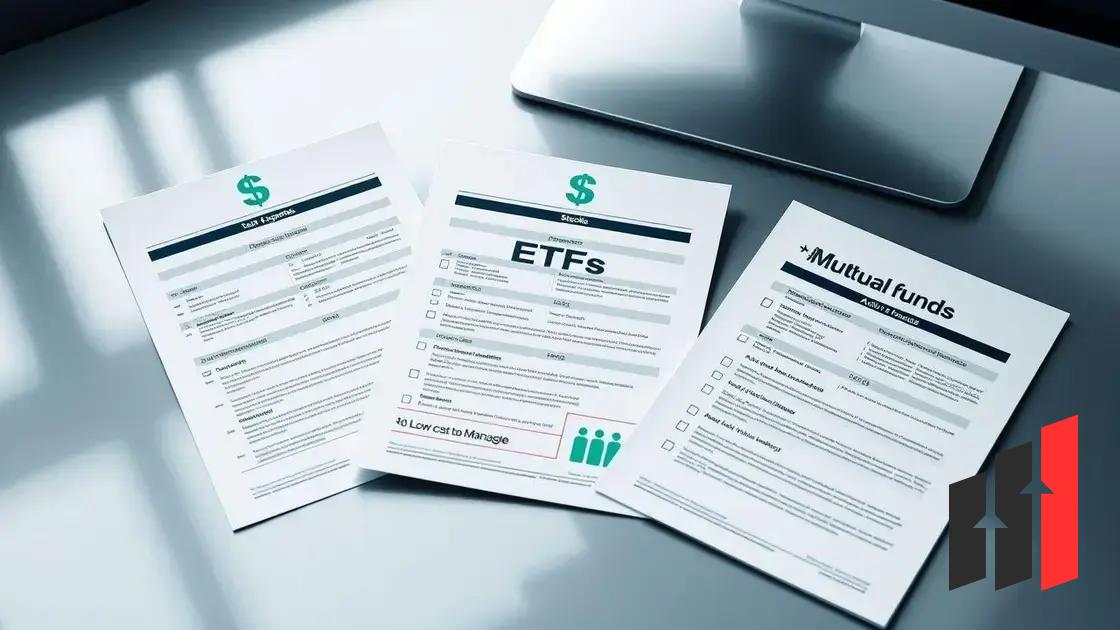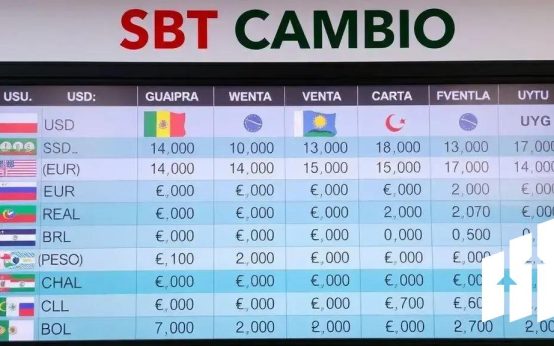The difference between stocks, ETFs, and mutual funds lies in ownership, trading flexibility, and management, with stocks representing company ownership, ETFs offering diversified portfolios traded like stocks, and mutual funds pooling money managed by professionals for broad investment exposure.
The Difference Between Stocks, ETFs, and Mutual Funds might seem confusing at first, right? But getting to know how each one works can change how you invest your money. Ever wondered which fits better in your portfolio? Let’s dive into their main traits and what makes them tick.
understanding stocks: ownership and risks
Stocks represent partial ownership in a company. When you buy stocks, you become a shareholder and own a piece of that business. This ownership can entitle you to voting rights in company decisions and a share of profits through dividends, depending on the stock type.
How Stocks Work
Stocks are traded on stock exchanges, where prices change based on supply, demand, and company performance. The value of stocks can fluctuate widely, reflecting the company’s success or challenges as well as market conditions.
Risks Involved in Stocks
Investing in stocks can be risky because their prices are volatile. If a company performs poorly or the market dips, stock prices may drop, causing investors to lose money. However, stocks generally offer higher growth potential compared to other investment types over time.
Understanding that stocks carry both the possibility of gains and losses is vital for any investor. Diversifying your stock holdings and researching companies can help manage these risks effectively.
what makes etfs flexible investment options

ETFs, or Exchange-Traded Funds, offer flexibility by combining features of stocks and mutual funds. They trade on stock exchanges just like individual stocks, allowing investors to buy and sell shares throughout the trading day at market prices.
Advantages of ETFs’ Flexibility
Liquidity is a key benefit—ETFs can be bought or sold anytime the market is open, unlike mutual funds which trade only once a day after market close. This allows investors to react quickly to market changes.
ETFs also provide diverse exposure since each fund holds a basket of different assets, such as stocks, bonds, or commodities. This built-in diversification can help reduce risk while still offering the ability to target specific sectors or strategies.
Another flexible feature is low cost. Because ETFs are often passively managed and track indexes, they typically have lower expense ratios compared to actively managed mutual funds, making them cost-effective choices for many investors.
Overall, ETFs give investors control, diversity, and cost advantages, making them flexible options that suit both beginners and experienced traders seeking efficient portfolio management.
mutual funds: pooling money for diverse portfolios
Mutual funds pool money from many investors to create a large fund that buys a varied mix of stocks, bonds, or other assets. This pooling allows investors to achieve broad diversification without needing a large amount of money individually.
How Mutual Funds Work
Professional fund managers select and manage the investments within the mutual fund. They decide which stocks or bonds to buy or sell based on the fund’s goals, whether it’s growth, income, or balanced investing.
Diversification is a major advantage — by spreading investments across many assets, mutual funds help lower risk compared to buying a single stock or bond. This makes them suitable for investors who want exposure to the market but prefer a less hands-on approach.
Mutual funds usually have fees, called expense ratios, which cover management and administrative costs. They are priced once a day based on the total value of the fund’s holdings, meaning you buy or sell shares at the end of the trading day.
Investors can choose from a variety of mutual funds that focus on different sectors, regions, or investment styles to match their financial goals and risk tolerance.
key differences in fees and management

Understanding the key differences in fees and management between stocks, ETFs, and mutual funds helps investors make smarter choices. Stocks usually have the lowest fees since you pay only commissions or trading fees when buying or selling.
ETFs Fees and Management
ETFs have expense ratios, which are annual fees based on a small percentage of your investment. These fees tend to be lower than mutual funds because many ETFs are passively managed, tracking indexes rather than actively selecting assets.
Mutual Funds Fees and Management
Mutual funds often come with higher fees. They may charge expense ratios and sometimes sales loads or commissions. This is because many mutual funds are actively managed, which means fund managers research and choose investments to try to outperform the market.
Active management can add value but also increases costs. Investors should compare fees carefully, as high costs can reduce overall returns over time.
In summary, stocks offer the lowest direct fees, ETFs balance cost and management style, and mutual funds tend to have the highest fees due to active management. Knowing these differences is crucial for building cost-effective portfolios.
how to choose between stocks, etfs, and mutual funds
Choosing between stocks, ETFs, and mutual funds depends on your financial goals, risk tolerance, and investment style. Stocks may be suitable if you want direct ownership and are comfortable with higher risk and market fluctuations.
Consider ETFs for Flexibility
ETFs offer a good balance of liquidity, diversification, and typically lower fees. They are a solid choice if you want a more hands-off approach but still want to trade throughout the day like stocks.
Mutual Funds for Professional Management
Mutual funds may fit investors seeking professional management and broad diversification without needing to manage daily trades. Keep in mind that mutual funds often have higher fees and trade only once per day.
Your choice also depends on the amount of capital you have, investment horizon, and how actively you want to manage your portfolio. For example, if you prefer active trading, stocks or ETFs might be better. If you want to set it and forget it, mutual funds might work well.
It’s important to assess your personal goals carefully and consider fees, tax implications, and flexibility before deciding. Many investors use a combination of these options to build a well-rounded portfolio.
Choosing the right investment for you
Understanding the differences between stocks, ETFs, and mutual funds is key to making smart investment choices. Each option offers unique benefits and risks depending on your goals and how involved you want to be.
Whether you prefer direct ownership with stocks, flexibility with ETFs, or professional management with mutual funds, knowing the details can help you build a balanced portfolio. Take time to consider fees, risks, and your personal investment style.
By making informed decisions, you can grow your wealth while managing risk effectively. Remember, a mix of these investment types may often work best to meet your financial goals.
FAQ – Common questions about stocks, ETFs, and mutual funds
What is the main difference between stocks, ETFs, and mutual funds?
Stocks represent ownership in a single company, ETFs are baskets of assets traded like stocks, and mutual funds pool money managed by professionals to invest in many assets.
Which investment is best for beginners?
ETFs and mutual funds are generally better for beginners because they offer diversification and are managed to reduce risk compared to individual stocks.
How do fees differ among stocks, ETFs, and mutual funds?
Stocks usually have low trading fees, ETFs have low annual expense ratios, while mutual funds often charge higher fees due to active management.
Can I trade ETFs throughout the day like stocks?
Yes, ETFs trade on stock exchanges during market hours, allowing you to buy and sell shares throughout the day.
Are mutual funds actively managed?
Many mutual funds are actively managed by professionals who select investments, but there are also passively managed mutual funds that track indexes.
How should I decide which investment to choose?
Consider your goals, risk tolerance, costs, and how actively you want to manage your investments. A mix of stocks, ETFs, and mutual funds is often ideal.


 Miran Highlights Dual Goals of Fed and Interest Rate Outlook
Miran Highlights Dual Goals of Fed and Interest Rate Outlook  Are You a Robot? Unusual Activity Detected on Bloomberg
Are You a Robot? Unusual Activity Detected on Bloomberg  Keir Starmer Leads Business Delegation to India for Trade Pact
Keir Starmer Leads Business Delegation to India for Trade Pact  Takaichi Appoints Ex-Finance Minister as Secretary General of LDP
Takaichi Appoints Ex-Finance Minister as Secretary General of LDP  Argentina Continues Dollar Sales Amid Weakened Peso Crisis
Argentina Continues Dollar Sales Amid Weakened Peso Crisis  White House Calls on Democrats to Resolve Ongoing Government Shutdown
White House Calls on Democrats to Resolve Ongoing Government Shutdown